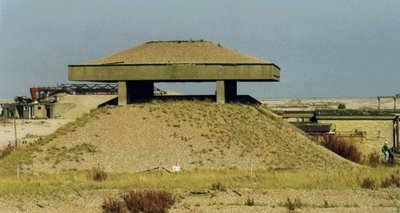Bunker Archaeology

"Walking along the beach some years ago, I noticed a dark structure emerging from the mist ahead of me," J.G. Ballard writes in today's Guardian. "Three storeys high, and larger than a parish church, it was one of the huge blockhouses that formed Hitler's Atlantic wall, the chain of fortifications that ran from the French coast all the way to Denmark and Norway. This blockhouse, as indifferent to time as the pyramids, was a mass of black concrete once poured by the slave labourers of the Todt Organisation, pockmarked by the shellfire of the attacking allied warships."

This wall of now abandoned concrete bunkers, Ballard tells us, was but part "of a huge system of German fortifications that included the Siegfried line, submarine pens and huge flak towers that threatened the surrounding land like lines of Teutonic knights. Almost all had survived the war and seemed to be waiting for the next one, left behind by a race of warrior scientists obsessed with geometry and death."

[Image: Richard Doody].
Ballard then climbs into one of the ruined blockhouses, and finds it reminds him "of the German forts at Tsingtao, the beach resort in north China that my family visited in the 1930s. Tsingtao had been a German naval base during the first world war, and I was taken on a tourist trip to the forts, a vast complex of tunnels and gun emplacements built into the cliffs. The cathedral-like vaults with their hydraulic platforms resembled Piranesi's prisons, endless concrete galleries leading to vertical shafts and even further galleries. The Chinese guides took special pleasure in pointing out the bloody handprints of the German gunners driven mad by the British naval bombardment."

[Image: Richard Doody].
And so on – we meet Modernism, ornament, Stalin, Hitler, London's National Gallery, the high-rise architecture of death and class warfare: read more at the Guardian.
Of course, in The Rings of Saturn, W.G. Sebald takes us on a walking tour of the English coast, including Britain's own military landscapes. These abandoned weapons testing ranges, complete with odd concrete structures, Sebald writes, looked like "the tumuli in which the mighty and powerful were buried in prehistoric times with all their tools and utensils, silver and gold. My sense of being on ground intended for purposes transcending the profane was heightened by a number of buildings that resembled temples or pagodas, which seemed quite out of place in these military installations. But the closer I came to these ruins, the more any notion of a mysterious isle of the dead receded, and the more I imagined myself amidst the remains of our own civilization after its extinction in some future catastrophe."

[Image: Keith Ward].
For Sebald, "wandering about among heaps of scrap metal and defunct machinery, the beings who had once lived and worked here were an enigma, as was the purpose of the primitive contraptions and fittings inside these bunkers, the iron rails under the ceilings, the hooks on the still partially tiled walls, the showerheads the size of plates, the ramps and the soakaways."
It is interesting to note that both Sebald and Ballard discuss an isle of the dead –

[Image: Arnold Böcklin, Isle of the Dead, 1883].
– specifically, in Ballard's case, Arnold Böcklin's famous 1883 painting of that title.
In any case, you can also take a look at the site Atlantik Wall for more images and history; you can follow Subterranea Britannica's journey into some weird missile silos –

[Image: Nick Catford].
– built into the landscape of northern France; you can read Paul Virilio's now somewhat legendary exploration of abandoned WWII landscape architecture, Bunker Archaeology; and you can take a brief look at the observations made here, as part of a larger architectural travelogue that begins in London's Barbican.
Of course, you can also take a look at an art project, from 1998, by Magdalena Jetelova –

– in which she laser-projected select quotations from, what else, Paul Virilio's Bunker Archaeology onto the half-submerged fortifications found scattered along Normandy's beaches.

Finally, here's a good interview with J.G. Ballard; and, though irrelevant to bunkers, I recommend Ballard's Super-Cannes in the highest possible terms. (Though it's certainly not for everyone who reads BLDGBLOG).





Comments are moderated.
If it's not spam, it will appear here shortly!
Fantastic post as always.
Also aptly timed as I've been reading up on the World War II quite a lot in the last month (to satisfy my own curiosity more than anything else). Interesting to get a modernist architectural slant on things...
Thank you.
in switzerland there are also very interesting bunkers:
for example http://tinyurl.com/ofj37
they camouflaged almost every bunker with the architectural style of the neighborhood.
there is also a book about those "chalets" but the info is in german:
http://tinyurl.com/mnsxr
http://tinyurl.com/nrakk
nck, thanks! I'll check those out. Also, a Google search for Hoxha and bunkers turns up a lot of interesting stuff.
And Timo, I owe you an email - I'll be in touch. (What are reading about WWII? Just curious).
i just found another very interesting photo:
http://de.wikipedia.org/wiki/Bild:Euschelsbunker.jpg
thank you for that post and for showing so many different positions of people that were working on this before, photographically aswell as contextual. i was working on a photographic documentary on those blockhouses over the last 4 years around cap ferret and i still do. the work deals with the disappearance of the blockers and the different stages and layers of that phenomenon an what it means. by now the texts are in german and french but an englisch translation will follow soon. maybe you want to check that out. all the best from austria. here's the link: http://lens.rotaug.com/la_disparition so long, markus
Post a Comment